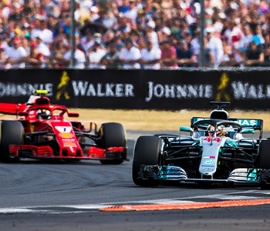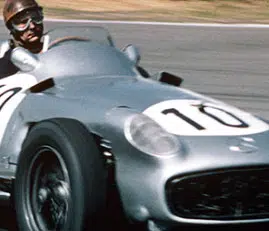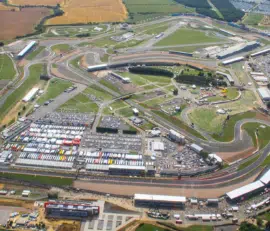Skip to GT race
After the fast straights of the Reims circuit the Grand Prix scene moved to the slow corners of the Aintree circuit, and all the regular contestants, plus many more, entered for the British Grand Prix. The Scuderia Ferrari entered their usual team of Phil Hill, von Trips and Ginther, with the rear-engined 120-degree V6-engined cars, and at the last minute F.I.S.A. entered Giancarlo Baghetti, and Ferrari lent them the rear-engined V60-degree engined car, and looked after both it and the driver. In view of the likelihood of rain at Aintree the cars were fitted with the sealed Perspex covers over the carburetter intakes, in place of the wire-mesh ones normally used. Porsche had the same three cars they had used at Reims, which were the old trailing link suspension ones with 4-cylinder engines on Weber carburetters, the new flat-8 still not being raceworthy, though undergoing much test-bed work. These were entered for Bonnier, Gurney and de Beaufort, the last-named being a private entry though looked after by the factory mechanics. There was little or no change among the British entries, everyone waiting seemingly in vain for the Coventry-Climax V8 engine and in the meantime doing the best they could with the Mark II 4-cylinder. Brabham and McLaren had the usual works Cooper cars, Ireland and Clark the two new Lotus cars, with 5-speed ZF gearboxes, Graham Hill and Brooks with B.R.M.s, all with Climax engines. Moss was driving the Rob Walker Lotus-Climax as used at Reims, and Surtees and Salvadori had the Yeoman Credit Team Coopers, the former having the Yeoman Credit special Cooper as a training car, now modified still further to take a Mark II Climax engine. U.D.T.-Laystall entered their two rebodied Lotus cars for Henry Taylor and Bianchi and had one of the older-type Lotus cars as a training car, this being fitted with the Laystall 5-speed gearbox, now modified internally and being given a thorough testing on the practice car. Camoradi entered Masten Gregory in their Cooper and Burgess in their Lotus, and H. & L. Motors of Stroud entered Jack Lewis in his 1961 Cooper-Climax. Private entries with old-type Lotus-Climax cars came from R. H. H. Parnell, Ashmore, Seidel and Mrs. Bryden-Brown, this last being the car Gurney has driven on occasions, only this time it was on loan to the Formula Junior driver Maggs. Marsh had his much-modified Lotus-Climax and Keith Greene was entered in the Gilby-Climax, a smart-looking car built on orthodox Lotus-cum-Cooper-cum-Lola lines by Gilby Engineering. The Scuderia Centro-Sud entered Bandini with their 1961 Cooper-Maserati and Natili with the early model of similar layout.
All these had been seen before in Formula One racing at some time or other, but a complete newcomer to racing and Formula One in particular was the Ferguson-Climax. This interesting machine was built and looked after by Ferguson Research Ltd., and entered by the R. R. C. Walker Racing Team, being painted in dark blue with a white band round the nose. The week before the British Grand Prix this car had made its debut at Silverstone in the Inter-Continental race, using a 2½-litre Climax engine, but it now had a 1½-litre Climax engine, and once again Fairman was the nominated driver though Moss had a keen interest in the car, it being entered as part of the Walker Equipe. This interesting newcomer to Grand Prix racing treads new ground in having 4-wheel drive from a front-mounted engine. The engine is canted to the right so that the crankshaft line lies to the left of the centre-line of the car, and it drives through a normal clutch to a 5-speed gearbox built by Ferguson Research in conjunction with Colotti. From the back of the gearbox transfer gears step the drive sideways towards the middle of the car and then propeller shafts take the drive fore and aft to small crownwheel and pinion units. At the point where the prop.-shafts take their drive from the transfer gearing there is a system of free-wheels and limited-slip differentials that ensure that the front prop.-shaft cannot rotate faster than the rear one and vice versa, thus preventing the possibility of wheelspin. Either all four wheels must spin, or none at all, and with the small amount of power produced by a Climax engine being distributed between the four tyres the result is that wheelspin, even due to “lifting” on corners, is ruled out. The two prop.-shafts are offset to the centre-line of the car and the rear one runs alongside the driver’s seat. Bevel gears turn the front and rear drives through 90 degrees onto two short shafts mounted in alloy housings the width of the chassis frame. At each end of these housings, both front and rear, are mounted Dunlop disc brakes and then short solid drive shafts with a type of “pot” universal take the drive to the wheels. These shafts are the same length as the bottom wishbones of the double-wishbone and coil-spring suspension units, and these bottom wishbones actually lie in the same horizontal plane as the shafts, the outer ends of the shafts passing through the apex of the wishbone. Tall hub-carrier posts are joined to top wishbones, with short stubby coil-spring/damper units supplying the suspension medium. All this mechanism is carried in a logical space-frame of small-diameter tubing and a very pretty body covers the whole thing, the shapely rounded tail being very Connaught-like, which is not surprising as Tony Rolt directs operations at Ferguson Research. The car uses 16-in. Dunlop alloy disc wheels, and, of course, Dunlop tyres, and is a delightfully well-balanced looking car, yet surprisingly small, but the outstanding feature is that the weight has been kept down so well that it is competitive with Cooper, Ferrari and B.R.M. on all-up Grand Prix rule weight, though not as light as Lotus, the Chapman wonders being in a class of their own. This car is full of interesting features and new thoughts on racing-car design, and among these is the use of the Dunlop Maxaret system of braking (described in detail in Motor Sport for January 1959). This briefly consists of hydraulic pressure for the brakes being of the “full-power” system, i.e., constant pressure provided by an engine-driven pump, from which the driver taps such pressure as he needs by a valve coupled to the brake pedal. In this system can be fitted the Dunlop Maxaret unit, which prevents a brake locking on no matter how hard the driver presses on the pedal. In the cockpit of the Ferguson is a simple control wheel for switching the Maxaret units on or off, their big advantage being on wet roads where normal braking systems, especially the powerful disc brakes, can so easily lock a wheel.





